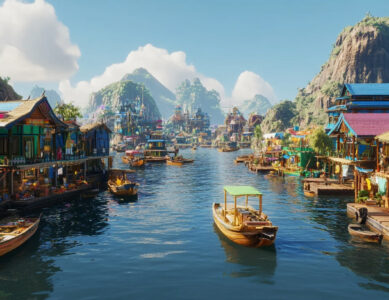Discover the fascinating world of floating villages and the unique lifestyles of communities living on water.
What Are Floating Villages?
Floating villages are communities built entirely on water, often comprising homes, schools, markets, and places of worship. These villages exist in harmony with their aquatic surroundings, offering a unique way of life deeply connected to nature. Found across the globe, floating villages showcase the ingenuity and resilience of people who have adapted to living on water.
Tonlé Sap, Cambodia: A Living Ecosystem
Tonlé Sap Lake in Cambodia is home to some of the most iconic floating villages in the world. These villages, such as Kampong Phluk and Chong Khneas, are built on stilts or pontoons, rising and falling with the lake’s seasonal water levels. The lake is not only a vital resource for the villagers but also a UNESCO biosphere reserve.
Visitors to Tonlé Sap can explore these vibrant communities by boat, witnessing daily life on the water. From fishing and cooking to attending floating schools, every aspect of life here revolves around the lake. It’s a rare glimpse into a sustainable lifestyle that has existed for generations.
Ha Long Bay, Vietnam: Tradition Meets Beauty
The floating villages of Ha Long Bay are set against a backdrop of dramatic limestone karsts and emerald waters. These communities, like Cừa Vạn, are small but rich in tradition. Villagers rely on fishing and aquaculture, cultivating pearls and other seafood for their livelihood.
Tourists can visit these villages to learn about traditional fishing methods, sample fresh seafood, and even stay overnight in floating accommodations. The blend of natural beauty and cultural heritage makes Ha Long Bay’s floating villages a must-see destination.
Lake Inle, Myanmar: A Unique Agricultural Approach
On Myanmar’s Lake Inle, floating villages like Nyaung Shwe are famous for their innovative agricultural practices. Villagers cultivate floating gardens, known as “kyun hmaw,” which are anchored to the lake bed with bamboo poles. These gardens produce crops like tomatoes and cucumbers, providing a sustainable food source.
Visitors can explore the lake by traditional longtail boats, observing the iconic leg-rowing fishermen and the daily life of the Intha people. Lake Inle’s floating villages are a testament to human ingenuity and harmony with the environment.
Makoko, Nigeria: The Venice of Africa
Known as the “Venice of Africa,” Makoko is a sprawling floating village on the Lagos Lagoon in Nigeria. This unique community is built on stilts and features a network of wooden walkways and canoes for transportation. Despite facing challenges like urban encroachment, Makoko remains a vibrant hub of culture and resilience.
Visitors can take guided tours to learn about the village’s history, architecture, and the daily lives of its residents. Makoko is a powerful example of how floating communities adapt to changing circumstances while preserving their heritage.
Sustainable Living in Floating Villages
Floating villages often operate as self-sustaining ecosystems, relying on renewable resources and traditional practices. Key features of their sustainable lifestyles include:
- Fishing and Aquaculture: Providing food and income while maintaining the balance of aquatic ecosystems.
- Floating Markets: Enabling trade and commerce without the need for roads.
- Eco-Friendly Construction: Using locally sourced materials like bamboo and recycled wood.
- Community Cooperation: Ensuring that resources are shared and preserved for future generations.
These practices not only support the villagers but also serve as inspiration for sustainable living worldwide.
Challenges Faced by Floating Villages
While floating villages are remarkable examples of adaptability, they face significant challenges. Rising sea levels, pollution, and urbanization threaten their existence. Many communities struggle to access basic amenities like clean water, healthcare, and education.
Efforts are underway to address these issues through initiatives such as eco-tourism, which brings financial support to these communities while raising awareness about their plight. Governments and NGOs are also working to improve infrastructure and promote sustainable development.
How to Experience Floating Villages Responsibly
If you’re planning to visit a floating village, it’s essential to do so responsibly. Here are some tips:
- Choose Ethical Tours: Select operators that prioritize the well-being of the community and the environment.
- Support Local Businesses: Purchase goods and services directly from villagers to help sustain their economy.
- Minimize Waste: Bring reusable items and avoid leaving trash behind.
- Respect Local Customs: Learn about the community’s traditions and interact with respect and curiosity.
- Educate Yourself: Take the time to understand the challenges faced by floating villages and consider ways to contribute to their preservation.
The Future of Floating Villages
Floating villages are at a crossroads, balancing tradition with modernization. As climate change and globalization impact their way of life, these communities are finding innovative ways to adapt. Projects like floating solar farms and sustainable tourism initiatives are paving the way for a future where floating villages can thrive.
By preserving their unique cultures and embracing sustainable practices, floating villages continue to inspire people around the world with their resilience and creativity.
Conclusion: Discover the Magic of Floating Villages
Floating villages are more than just places to live—they’re vibrant communities that embody the connection between humans and water. From the tranquil backwaters of Cambodia to the bustling lagoons of Nigeria, these villages offer a glimpse into a way of life that is both ancient and forward-thinking.
Ready to explore the world of floating villages? Discover their beauty, culture, and sustainability, and experience the magic of life on the water.










